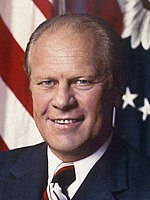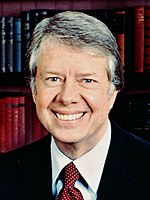| ||||||||||||||||||||||||||
| Turnout | 75.47% | |||||||||||||||||||||||||
|---|---|---|---|---|---|---|---|---|---|---|---|---|---|---|---|---|---|---|---|---|---|---|---|---|---|---|
| ||||||||||||||||||||||||||
 County Results
| ||||||||||||||||||||||||||
| ||||||||||||||||||||||||||
| Elections in Illinois |
|---|
 |
The 1976 United States presidential election in Illinois was held on November 2, 1976. All 50 states and The District of Columbia, were part of the 1976 United States presidential election. State voters chose 26 electors to the Electoral College, who voted for president and vice president.
In the last two presidential elections, Illinois had voted Republican. In 1972, the state had, like the rest of the nation outside Massachusetts and the District of Columbia, voted strongly for Richard Nixon who carried every county except college-dominated Jackson, although Democrat George McGovern ran 3% above his national vote percentage in the state. This is one of two times in the 20th century that the state voted for a losing candidate (the other being 1916).
By the second week of September polls were showing Carter ahead of incumbent President Gerald Ford by 14% but running much weaker in the emerging Rust Belt industrial states[1] – his lead in Illinois would be estimated at four percentage points.[2] A few days later another poll had Ford already ahead in Illinois,[3] but another poll had the incumbent President narrowly behind.[4]
Defeated Republican primary candidate and future President Ronald Reagan helped Ford in his fall campaign in Illinois,[5] although Carter preceded him in visiting the state – doing so for the first time on September 24.[6] Ford’s running mate Bob Dole followed Carter to the state and said that Carter had “3 positions on every issue” during a tour through Rock Island, Quincy and Decatur. At this time it was also thought that Ford was helped by the strong GOP gubernatorial campaign of James R. Thompson.[7]
At the beginning of October, Illinois was viewed as “too close to call”,[8] before Carter paid a second visit to the state – with the support of Chicago Mayor Richard Daley viewed essential to his chances of carrying the state’s electoral votes due to the coolness of the northern and central parts of the state toward a Southern Evangelical Democrat.[9] Carter would subsequently move ahead, but the state remained very close as election day neared, with South Side black voters considered a critical aspect of Carter’s hopes.[10]
Gerald Ford won Illinois with 50.10 percent of the vote,[11] but lost the general election to Jimmy Carter of Georgia. Illinois’ result was 4% more Republican than the nation at large.
Ford's win was due to his large majorities in the traditionally Republican collar counties, chiefly DuPage, which he won by a margin ten thousand votes greater than his statewide total margin. Carter did well in Cook County and Dixie Southern Illinois, but his majorities there were much smaller than New Deal era Democrats had won. As of the 2020 presidential election, this is the last time that a Democrat won the White House without carrying Illinois (one of only three such elections, the others being 1884 and 1916), and also the most recent presidential election when Illinois would vote more Republican than the nation. This was the only election between 1920 and 1996 where Illinois did not back the nationwide winner.
- ^ Harris, Louis. ‘Carter leads Ford, 53—39: Harris Survey’; The Boston Globe, September 9, 1976, p. 23
- ^ Broder, David; ‘Carter still for firing FBI chief’; The Boston Globe, September 10, 1976, p. 13
- ^ ‘Ford buoyed by new polls in Michigan, Kansas’; The Boston Globe, September 13, 1976, p. 8
- ^ Cannon, Lou; ‘Ford's Campaign Strategy: Stress Consistency, Record’; The Washington Post, September 15, 1976, p. A4
- ^ ‘Lydon, Christopher; Reagan Is Too Busy to Aid Ford in 5 States’; The New York Times, September 20, 1976, p. 22
- ^ Wicker, Tom; ‘Carter in Illinois’; The New York Times, September 24, 1976, p. 25
- ^ Kneeland, Douglas E.; ‘Dole Is Stepping Up Attacks on Carter: Kansas Senator, Stumping in Ohio and Illinois, Says Democrat Has 3 Positions on Every Issue’; New York Times, September 29, 1976, p. 22
- ^ Apple, R.W.; ‘Poll Shows Carter Is Ahead in States Needed for Victory’; The New York Times, October 3, 1976, p. 1
- ^ Evans, Rowland and Novak, Robert; ‘Carter’s Illinois Strategy’; The Washington Post, October 8, 1976, p. A25
- ^ Kaiser, Robert; ‘Black Vote Could Carry Carter to Victory’; The Boston Globe, October 28, 1976, p. 2
- ^ "1976 Presidential General Election Results – Illinois". Dave Leip's Atlas of U.S. Presidential Elections. Retrieved June 4, 2019.

